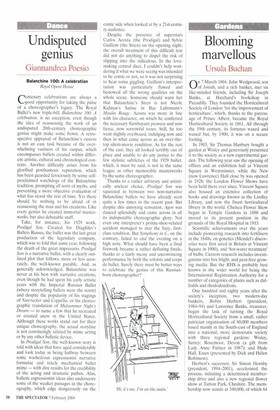Undisputed genius
Giannandrea Poesio
Balanchine 100: A celebration Royal Opera House
Centenary celebrations are always a good opportunity for taking the pulse of a choreographer's legacy. The Royal Ballet's new triple-bill, Balanchine 100: A celebration, is no exception, even though the idea of reassessing the work of an undisputed 20th-century choreographic genius might make some frown. A retrospective appraisal of Balanchine's oeuvre is not an easy task because of the overwhelming vastness of his output, which encompasses ballets created within different artistic, cultural and chronological contexts. Another difficulty arises from his glorified posthumous reputation, which has been guarded ferociously by some selfproclaimed watchdogs of the Balanchine tradition, prompting all sorts of myths, and preventing a more objective evaluation of what has stood the test of time. Yet there should be nothing to be afraid of in reassessing the man and his creations. Like every genius he created immortal masterworks, but also debatable stuff.
Take, for instance, his 1929 work, Prodigal Son. Created for Diaghilev's Ballets Russes, the ballet was the last great production of the legendary company, which was to fold that same year, following the death of the great impresario. Prodigal Son is a narrative ballet, with a clearly outlined plot that follows, more or less accurately, the well-known parable. And, as generally acknowledged. Balanchine was never at his best with narrative creations, even though he had spent his early artistic years with the Imperial Russian Ballet (where storytelling ballets were the norm) and despite the popularity of his stagings of Nutcracker and Coppelia, or his choreographic translation of Midsummer Night's Dream — to name a few that he recreated or created anew in the United States. Although these works stand out for their unique choreography, the actual storylinc is not convincingly related by mime acting or by any other balletic device.
In Prodigal Son, the well-known story is told with ideas that have aged considerably and look today as being halfway between some washed-out expressionist narrative formulae and tritely mechanical ballet mime — with dire results for the credibility of the acting and dramatic pathos. Alas, balletic expressionist ideas also underscore some of the weaker passages in the choreography, which edge dangerously on the comic side when looked at by a 21st-century audience.
Despite the presence of superstars Carlos Acosta (the Prodigal) and Sylvie Guillem (the Siren) on the opening night, the overall treatment of this difficult text did not do anything to dispel the risk of slipping into the ridiculous. In the lovemaking central duet, I couldn't help wondering if what we were seeing was intended to be comic or not, so it was not surprising to hear some giggling. Guillem's interpretation was particularly flawed and bestowed all the wrong qualities on the whole scene. Someone should warn her that Balanchine's Siren is not Nicole Kidman's Satine in Baz Luhrmann's Moulin Rouge. Acosta was more in line with his character, on which he conferred the necessary flamboyant prowess and now fierce, now sorrowful tones. Still, he too went slightly overboard, indulging now and then in what came across as an over-thetop silent-movie rendition. As for the rest of the cast, they all looked terribly out of place and unable to do any justice to the few stylistic subtleties of the 1929 ballet, which, it must be said, is not in the same league as other memorable masterworks by the same choreographer.
Thanks to a rather arbitrary and artistically unclear choice, Prodigal Son was squeezed in between two non-narrative Balanchine ballets we have already seen quite a few times in the recent past. But despite this annoying sensation, Agon was danced splendidly and came across in all its indisputable choreographic glory. Not even one interpreter's pointe-shoe-related accident managed to mar the fizzy, firstclass rendition. But Symphony in C, on the contrary, failed to end the evening on a high note. What should have been a final firework became a rather deflating finale, thanks to a fairly messy and unconvincing performance by both the soloists and corps de ballet, Surely there must be better ways to celebrate the genius of this Russianborn choreographer?


























































 Previous page
Previous page